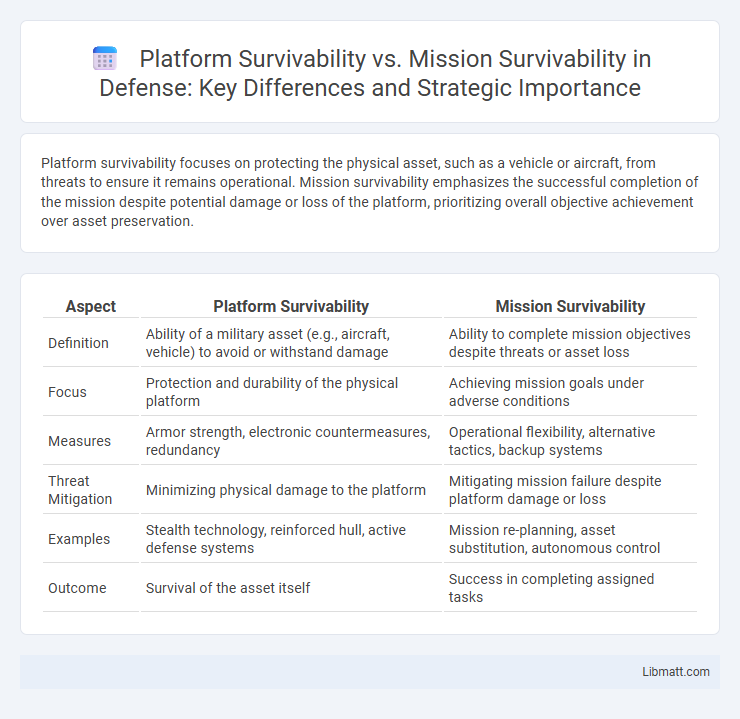Platform survivability focuses on protecting the physical asset, such as a vehicle or aircraft, from threats to ensure it remains operational. Mission survivability emphasizes the successful completion of the mission despite potential damage or loss of the platform, prioritizing overall objective achievement over asset preservation.
Table of Comparison
| Aspect | Platform Survivability | Mission Survivability |
|---|---|---|
| Definition | Ability of a military asset (e.g., aircraft, vehicle) to avoid or withstand damage | Ability to complete mission objectives despite threats or asset loss |
| Focus | Protection and durability of the physical platform | Achieving mission goals under adverse conditions |
| Measures | Armor strength, electronic countermeasures, redundancy | Operational flexibility, alternative tactics, backup systems |
| Threat Mitigation | Minimizing physical damage to the platform | Mitigating mission failure despite platform damage or loss |
| Examples | Stealth technology, reinforced hull, active defense systems | Mission re-planning, asset substitution, autonomous control |
| Outcome | Survival of the asset itself | Success in completing assigned tasks |
Introduction to Platform vs Mission Survivability
Platform survivability refers to the ability of a specific military asset, such as an aircraft or vehicle, to withstand or evade threats and continue functioning in hostile environments. Mission survivability emphasizes the successful completion of operational objectives despite enemy actions or system failures, often relying on a combination of platform resilience, redundancy, and tactical flexibility. Understanding the distinction highlights the importance of designing both robust platforms and adaptive mission strategies to ensure operational effectiveness in contested scenarios.
Defining Platform Survivability
Platform survivability refers to the ability of a physical system or vehicle to avoid or withstand damage that could degrade its operational effectiveness during combat or hazardous conditions. It encompasses protection measures such as armor, countermeasures, and stealth technology designed to safeguard the platform itself. Your understanding of platform survivability is crucial for assessing how well a system can sustain damage while remaining functional, distinct from mission survivability which emphasizes the success of overall objectives.
Defining Mission Survivability
Mission survivability refers to the ability of a system to continue fulfilling its intended operational objectives despite facing threats or adverse conditions, emphasizing the preservation of critical functions. Platform survivability focuses on the physical protection and resilience of the hardware or infrastructure itself. Understanding mission survivability helps you prioritize strategies that ensure sustained performance and success even if the platform experiences damage or degradation.
Key Differences Between Platform and Mission Survivability
Platform survivability emphasizes the protection and resilience of the physical asset or system itself, including its structure, armor, and onboard countermeasures. Mission survivability focuses on ensuring the achievement of operational objectives despite threats, often through redundancy, alternate tactics, or support systems. Understanding these distinctions helps you optimize defense strategies by balancing asset preservation with mission success in hostile environments.
Factors Affecting Platform Survivability
Factors affecting platform survivability include stealth technology, armor strength, and electronic countermeasures that reduce detectability and enhance defense against threats. Robust maintenance protocols and system redundancies improve reliability and operational endurance in hostile environments. Integration of advanced sensors and situational awareness tools enables rapid threat identification and response, directly contributing to increased platform survivability.
Factors Influencing Mission Survivability
Mission survivability depends on a combination of platform survivability and external factors such as enemy capabilities, environmental conditions, and mission complexity. Effective mission planning integrates threat assessment, redundancy, and adaptive tactics to maintain operational effectiveness despite platform damage or loss. Your ability to anticipate and mitigate these factors directly enhances the likelihood of mission success.
Technological Solutions for Enhancing Survivability
Technological solutions for enhancing platform survivability encompass advanced armor composites, electronic warfare systems, and cyber defense mechanisms that protect the physical and digital integrity of military assets. Mission survivability relies on integrated sensor fusion, real-time data analytics, and autonomous decision-making algorithms to maintain operational continuity amidst adverse conditions. Both approaches harness artificial intelligence and resilient communication networks to mitigate threats and ensure success in contested environments.
Operational Strategies for Improving Mission Success
Effective operational strategies for enhancing mission success prioritize mission survivability over mere platform survivability by ensuring redundant systems, adaptive tactics, and real-time threat assessment. Emphasizing flexible resource allocation and dynamic decision-making allows your mission objectives to continue despite platform compromises. Integrating advanced communication networks and resilience planning directly supports sustained operational capabilities in contested environments.
Case Studies: Platform Failure vs Mission Success
Case studies demonstrate that platform survivability often contrasts with mission survivability, where platform failure does not always equate to mission failure. For example, the Mars Pathfinder mission achieved success despite hardware anomalies, showing that robust software and fallback systems can ensure mission survivability even if the platform is compromised. Understanding these distinctions helps optimize your designs for mission outcome rather than solely focusing on platform integrity.
Future Trends in Survivability Concepts
Future trends in survivability concepts emphasize integrating artificial intelligence and autonomous systems to enhance both platform survivability and mission survivability by enabling real-time threat detection and adaptive response mechanisms. Advanced materials and stealth technologies improve platform resilience against emerging threats, while network-centric warfare strategies ensure mission continuity despite platform degradation or loss. The convergence of cyber defense and electronic warfare capabilities further fortifies survivability, supporting sustained operational effectiveness in contested environments.
platform survivability vs mission survivability Infographic

 libmatt.com
libmatt.com